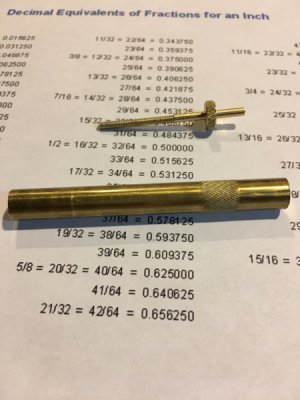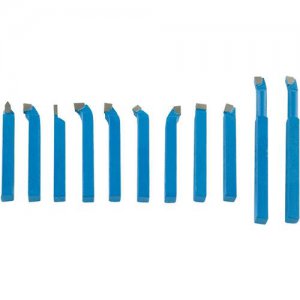Pictured is a "screw" I am making from 3/8" rod. The ones that get completed seem to be out of sheer luck as many fail because my order in turning the different parts always ends up with some issue. I have tried mixing the order up. I get the best results doing this order:
1. Cut rod to 2.5" long.
(Final length is about 2".)
2. Create knurl (lol)
3. Turn first 1.125" of long end aside knurl to .109".
4. Thread turned end to 4-40
5. Connect live center to threaded end and continue turning after threads, up to the knurl. Again turn to .109".
6. Camfer knurl on turned side.
7. Take out piece and screw into steel tube.
I made a 1.5" long, 1/4" OD steel tube with an ID just over .109" and threaded to 4-40 at one end.
8. Insert steel tube with brass piece into 3-jaw chuck.
9. Turn short end of brass piece up to the knurl to an OD of .109".
10. Camfer this side of knurl, making a 1/8" wide knurl for turning "screw" with finger tip.
10. Grind threaded end so that threads are 1" long. Grind short end so that total length of "screw" is 2" long.
DONE
Without going into the issues I am having, would you all take this approach or do it differently?
Would you change the order of things?

1. Cut rod to 2.5" long.
(Final length is about 2".)
2. Create knurl (lol)
3. Turn first 1.125" of long end aside knurl to .109".
4. Thread turned end to 4-40
5. Connect live center to threaded end and continue turning after threads, up to the knurl. Again turn to .109".
6. Camfer knurl on turned side.
7. Take out piece and screw into steel tube.
I made a 1.5" long, 1/4" OD steel tube with an ID just over .109" and threaded to 4-40 at one end.
8. Insert steel tube with brass piece into 3-jaw chuck.
9. Turn short end of brass piece up to the knurl to an OD of .109".
10. Camfer this side of knurl, making a 1/8" wide knurl for turning "screw" with finger tip.
10. Grind threaded end so that threads are 1" long. Grind short end so that total length of "screw" is 2" long.
DONE
Without going into the issues I am having, would you all take this approach or do it differently?
Would you change the order of things?


